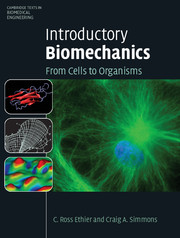Book contents
- Frontmatter
- Contents
- About the cover
- Preface
- 1 Introduction
- 2 Cellular biomechanics
- 3 Hemodynamics
- 4 The circulatory system
- 5 The interstitium
- 6 Ocular biomechanics
- 7 The respiratory system
- 8 Muscles and movement
- 9 Skeletal biomechanics
- 10 Terrestrial locomotion
- Appendix: The electrocardiogram
- Index
- Plate section
- References
3 - Hemodynamics
Published online by Cambridge University Press: 05 June 2012
- Frontmatter
- Contents
- About the cover
- Preface
- 1 Introduction
- 2 Cellular biomechanics
- 3 Hemodynamics
- 4 The circulatory system
- 5 The interstitium
- 6 Ocular biomechanics
- 7 The respiratory system
- 8 Muscles and movement
- 9 Skeletal biomechanics
- 10 Terrestrial locomotion
- Appendix: The electrocardiogram
- Index
- Plate section
- References
Summary
The term hemodynamics comes from the Greek words haima (blood) and dunamis (power) and refers to the movement and deformation (i.e., flow) of blood, and the forces that produce that flow. In this chapter we will examine this fascinating (and complex) topic.
Everyone is familiar with blood's role as a transport medium: it carries oxygen and nutrients to metabolically active tissues, returns carbon dioxide to the lungs, delivers metabolic end-products to the kidneys, etc. However, the reader should be aware that blood does much more than simply deliver substances to target tissues. For example, it:
provides a buffering reservoir to control the pH of bodily fluids
serves as an important locus of the immune system
transports heat, usually from centrally located tissues to distal ones, in order to help maintain a suitable temperature distribution throughout the body.
Unfortunately, in this book we will not be able to examine all of these roles, and to a large extent we will simply view blood as a passive carrier, a fluid that transports physiologically important compounds within the body. However, within this context, it will soon become clear that something so “simple” as an analysis of blood flow as a transport mechanism is non-trivial. We begin by examining blood rheology.
Blood rheology
Rheology is the study of how materials deform and/or flow in response to applied forces. The applied forces are quantified by a quantity known as the stress, defined as the applied force per unit area.
- Type
- Chapter
- Information
- Introductory BiomechanicsFrom Cells to Organisms, pp. 119 - 163Publisher: Cambridge University PressPrint publication year: 2007
References
- 1
- Cited by



